Tokyo Metropolitan Art Museum
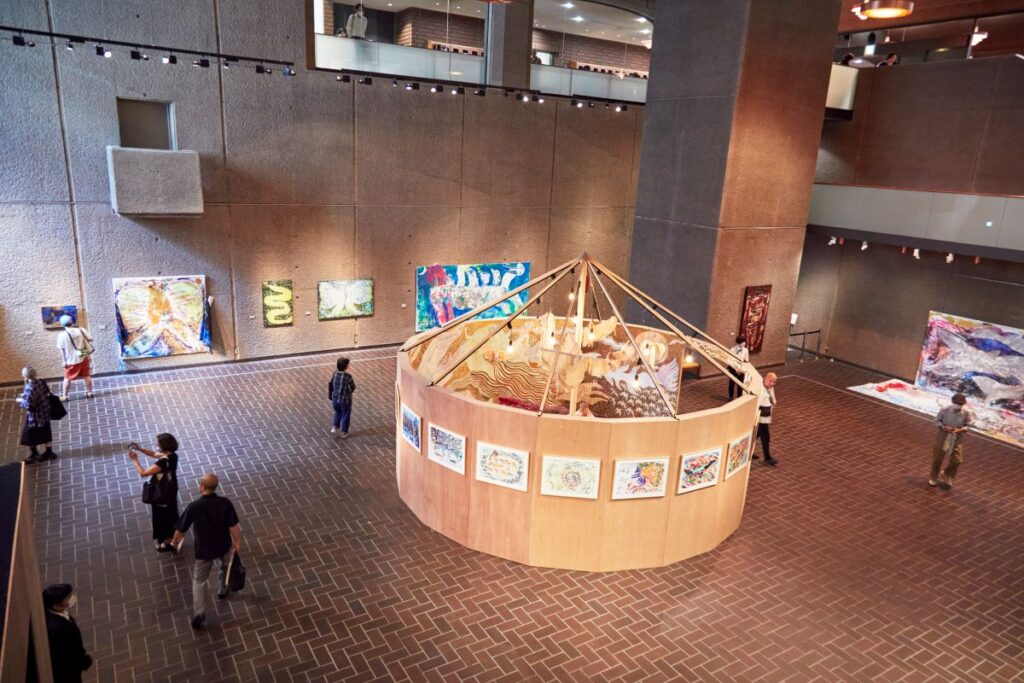
We have received a report from Tokyo Metropolitan Art Museum on the special exhibition “Listening to the Earth: Presence and Texture,” which opened on Saturday, July 20, 2024, so we would like to share it with you.
The Tokyo Metropolitan Art Museum’s special exhibition, “Listening to the Earth: Presence and Texture,” opened on Saturday, July 20th. The exhibition features works by five contemporary artists who are deeply connected to nature and continue to create, conveying the breath of the earth, which is difficult to hear in our human-centered lives. A press preview was held on Friday, July 19th, and the exhibition was open to the press. This article reports on the exhibition commentary by Ohashi Natsuko, the curator in charge of the exhibition, and the participating artists.
■ The feeling and texture of listening to the earth
■Saturday, July 20, 2024 to Wednesday, October 9, 2024
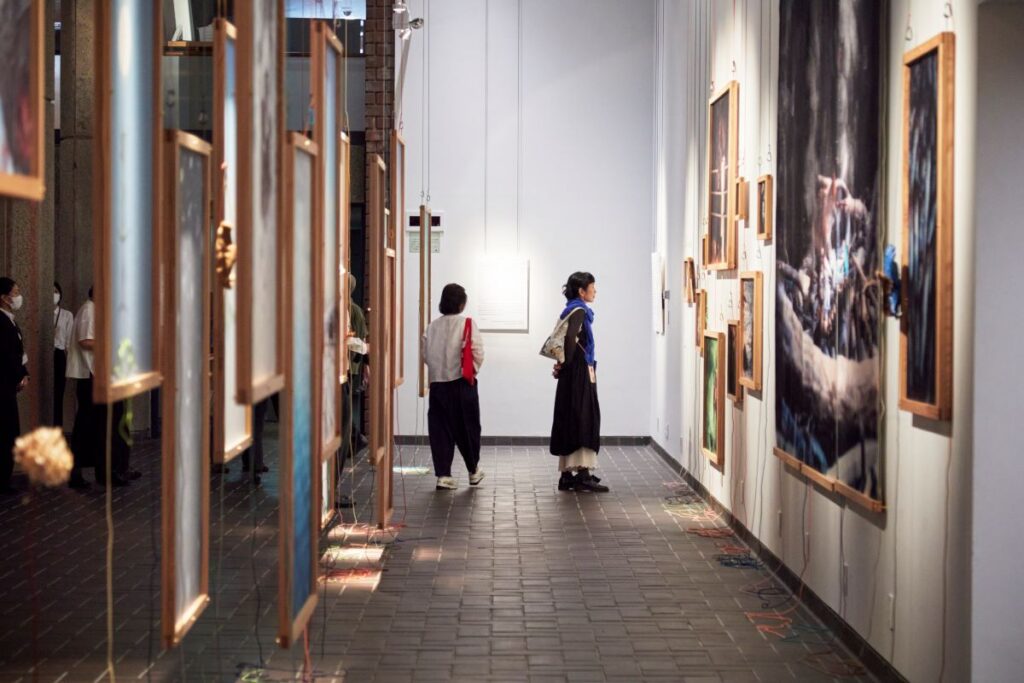
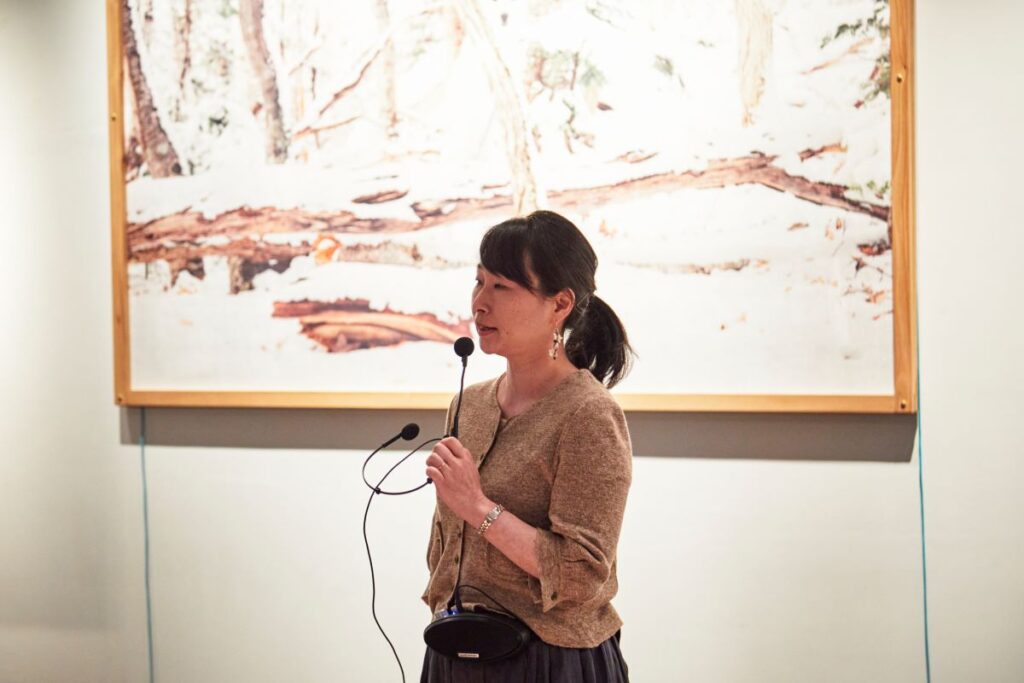
Curator Natsuko Ohashi, who was in charge of this exhibition, explained the background of the project, saying, “Over the past dozen years, there have been many times when we have felt the convenience of living in a big city, along with its fragility, such as the Great East Japan Earthquake and the spread of COVID-19. In addition to feeling the fragility of the city, I also felt that nature was somewhat distant, and that my ability to sense not only the changing of the seasons, but also the state and changes of nature, was gradually weakening. This was the big trigger for me to proceed with the research,” and the exhibition features artists who have left big cities to sharpen their senses in nature and create their works.
The participating artists are five people who have a deep connection with nature in their work: Kawamura Kiichi, Furusaka Haruka, Mimoko Machiko, Kurashina Mitsuko, and Enomoto Yuichi.
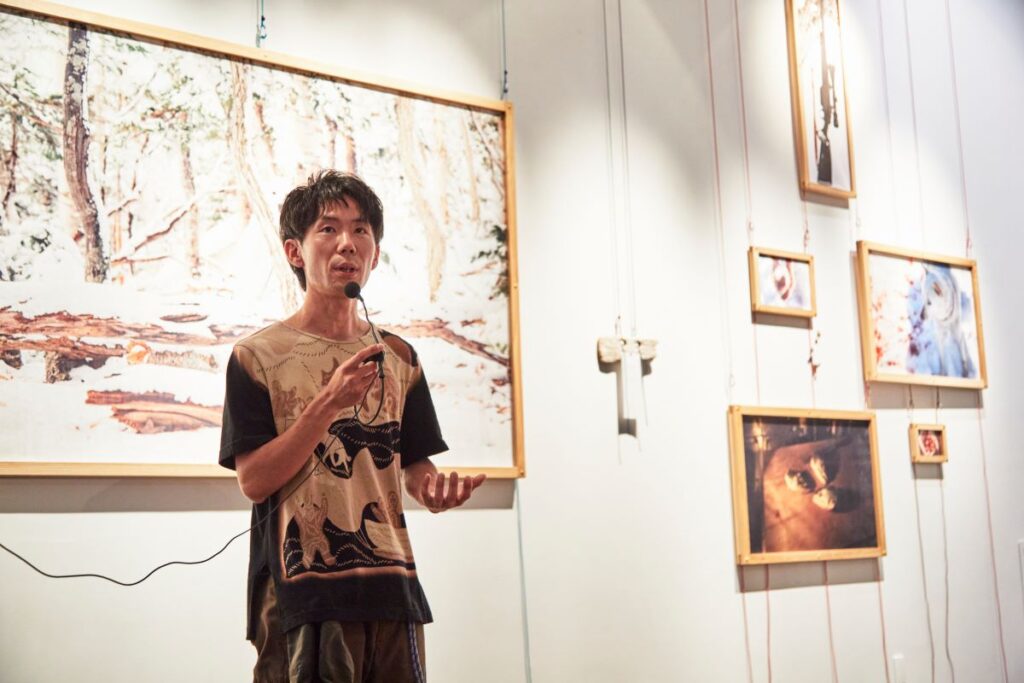
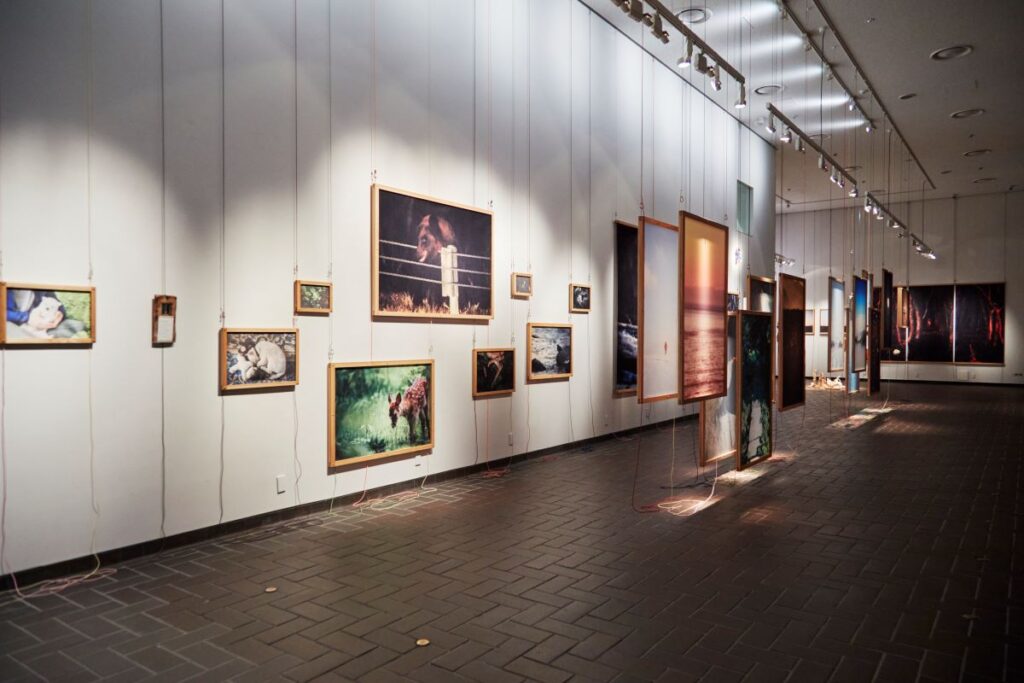
As you enter the exhibition hall (Gallery C) just after descending the escalator at the entrance, you will find an installation of photographs by Kiichi Kawamura in a high-ceilinged, open space. Born and raised in Tokyo, Kawamura (born in 1990) moved to the Shiretoko Peninsula in Hokkaido in 2017 and continues to work as an artist.
“It is a place known as a World Heritage Site. Brown bears, killer whales, and sometimes whales come here, and while it is rich in nature, it also lives in a very harsh environment. Rather than the so-called nature photography that puts the word “nature” in quotation marks, I create my work with the desire to express myself as a resident living there, feeling the local climate with my own skin,” he says. In the autumn of his second year after moving here, he obtained a hunting license and went into the mountains to hunt. Although he started out with a desire to learn more about nature and animals, at first he felt that he was not accepted by the forest and it was difficult to meet animals. If you do not understand the terrain and the ecology of the creatures living in that area, you cannot walk through the area or reach your prey.
“I live in Shiretoko because I’m conscious of the issues that you can’t feel or understand in the city, but rather than looking at the ecosystem from the outside through hunting, I want to be part of it, and link the spirituality and process of the act with the expression of photography.” (Kawamura)
The photographs printed on fabric capture Kawamura’s daily life, including his life with his Ainu dog Upashi, who is a member of his family, and the scenery of Shiretoko. Framed in wooden frames made in Hokkaido, the photographs are hung with ropes used for outdoor camping, forming the exhibition space. In consideration of the environment and respecting the architecture of the museum, no new walls were erected for the exhibition. The way the works are comfortably arranged in the space will be a fresh sight for viewers. The wooden frames are foldable. The artist himself packs them all into his car and transports them to the venue, where they are exhibited. After the exhibition ends, he folds them up again and drives them back to Shiretoko. This is probably also part of the process that Kawamura, who values the continuity of life, production, and exhibition, speaks of.
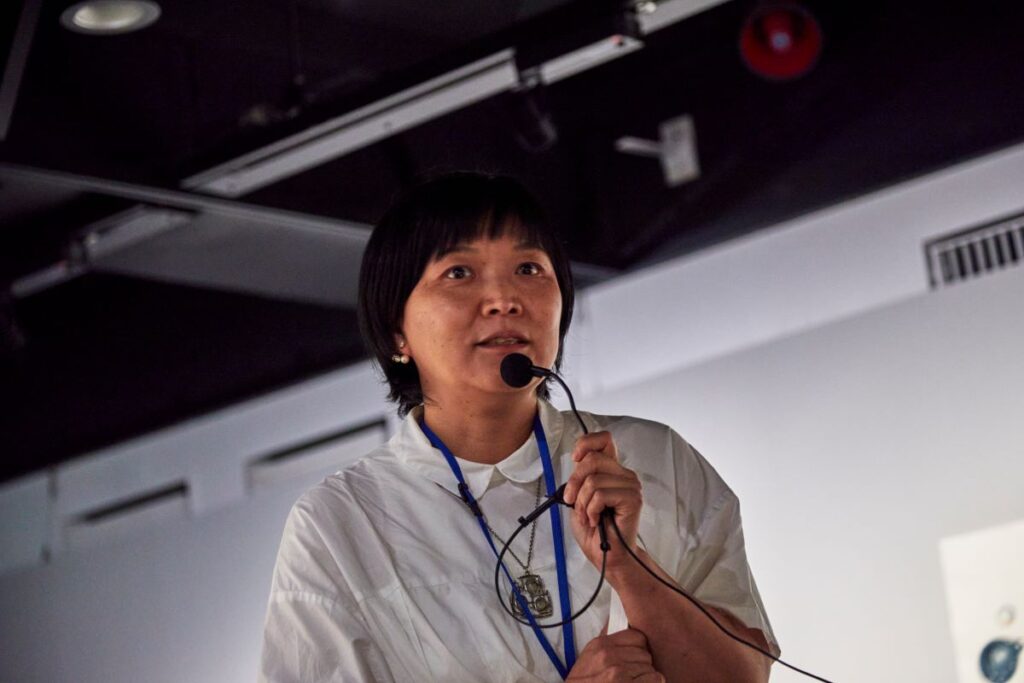
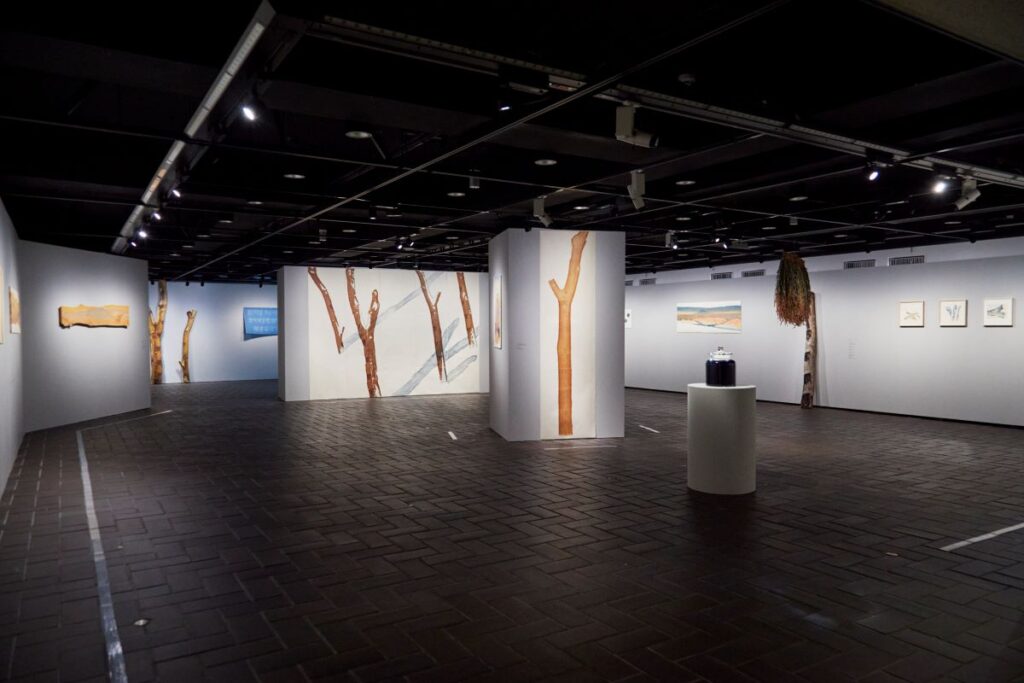
Woodblock artist Furusaka Haruka was born in Osaka Prefecture. After spending time in Finland, Norway and other parts of Northern Europe, she began working in Aomori in 2017, interviewing people who live in harmony with nature. This exhibition features three themes: the print series Duodji of Reindeer Mountain, which was created in response to her fascination with the handicrafts of the nomadic Sámi people of Northern Europe; Soma’s Boat and Voice of a Message, which were created after extensive research in the mountainous regions of Aomori and Minami-Tsugaru.
Furusaka sees the trees in his woodblock prints as a way to connect with nature. He says that this view was largely influenced by his first stay and production in a Sámi village in 2003. Since then, he has communicated with the Sámi villagers via e-mail and other means, gradually learning what it is like to live alongside the harsh natural environment.
“Reindeer Fur” was inspired by the Sámi people, who have long survived in regions where temperatures can reach minus 40 degrees Celsius by wearing reindeer fur. When they catch a reindeer, they use everything from the fur to the bones and tendons to survive. For Furusaka, woodblock prints are like reindeer to the Sámi. Making woodblock prints made him want to live like the Sámi and reindeer, so he started making prints by making use of the shape and grain of the solid wood and using dirt he picked up as paint. This was the beginning of the “Duoji of Reindeer Mountain” series.
In “Weaving,” people tie warp threads to trees in the forest, adjust the tension, and feel the lightness of doing handiwork in nature, as well as the comfort of being there. “I recorded their words about how to behave in nature and created my work,” he says.
In 2017, he turned his attention to Japan and began to visit Aomori to interview people who have lived with the harsh winter. For this exhibition, he produced a large woodblock print that matches the ceiling height of the venue. He was present from the felling of the wood for the printing block in the lacquer forest, and printed the new work using lacquer sap from Aomori and indigo that he grew himself. Not only the woodblock prints but also the printing blocks are exhibited at the venue, creating an exhibition space resembling an Aomori grove. In addition, natural materials such as lacquer sap, indigo, and soil that Furusaka uses as paint are also exhibited. In “Vessel that Makes Lines,” Aomori hiba is thinly coated with mud collected in Aomori. As it dries, it cracks little by little to create lines in the installation, and you can observe how it changes as the exhibition period progresses.
In addition, a video is being shown that records the process of creating woodblock prints in response to the nature of his hometown. From harvesting indigo in summer, cutting down wood in winter, collecting soil, to carving and printing, the video shows how closely his hometown is connected to nature, and how the process of creating woodblock prints, which begins with growing the materials, takes an enormous amount of time and effort. The video was shot by Kiichi Kawamura, a participating artist in this exhibition.
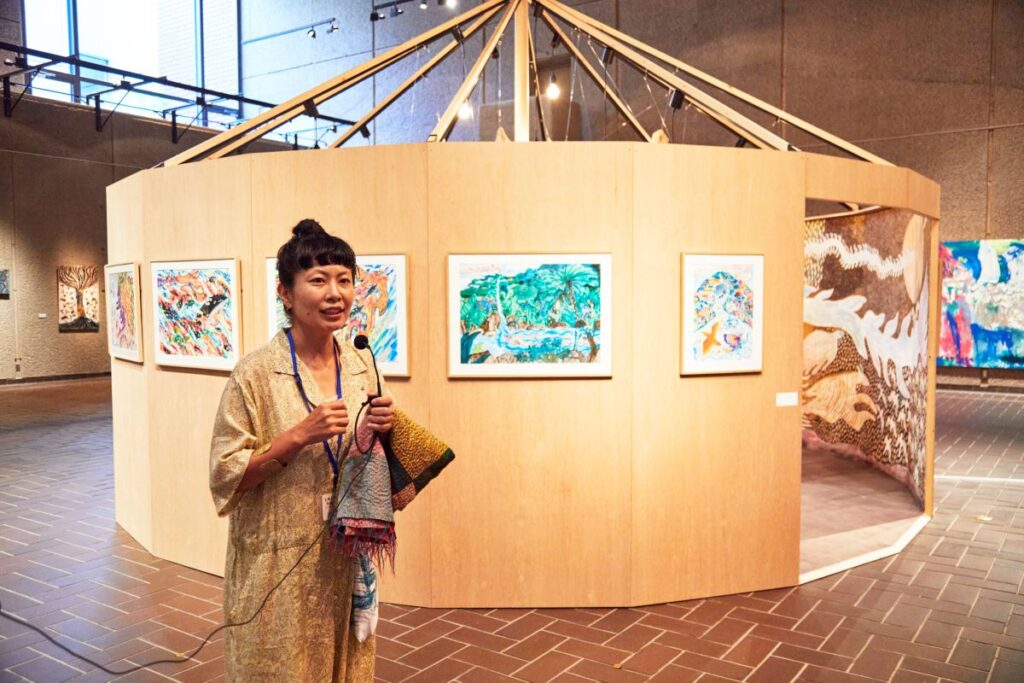
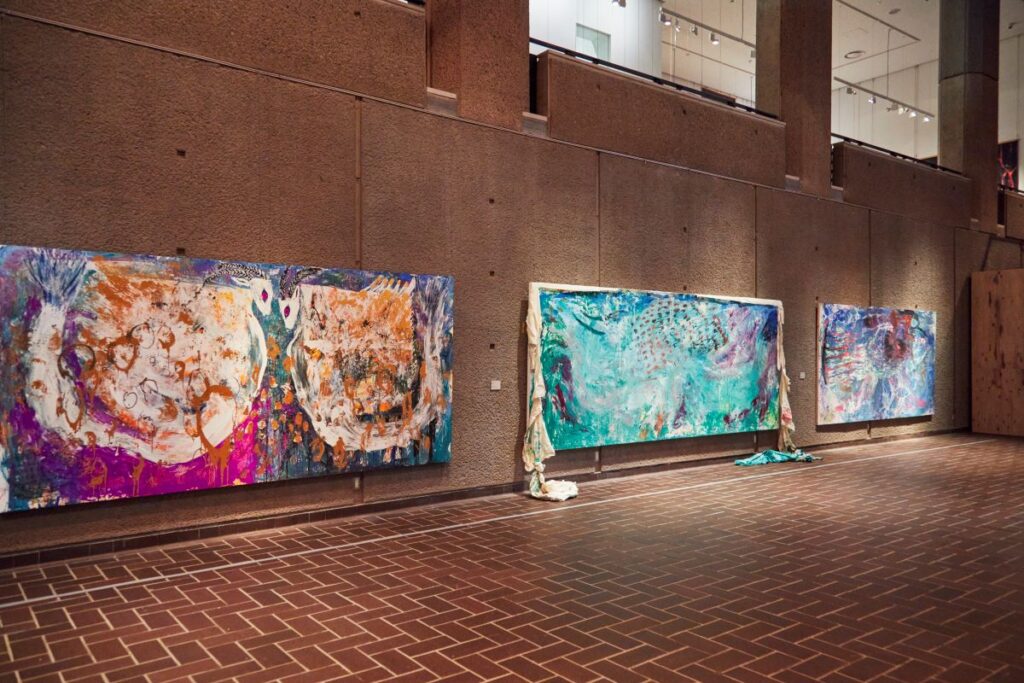
The atrium exhibition room on the floor below (Gallery A) is home to the dynamic world of Machiko Mimoko’s work. Born in Osaka Prefecture, Machiko Mimoko moved to Amami Oshima in 2019 after 11 years of work in Tokyo. An “island” has been created in the center of the exhibition space, and many of the works she created on Amami Oshima are on display around it.
Miroko Machiko says that because the people of Amami Oshima live in harmony with nature, they have a strong ability to sense it.
“I realized that I had no ability to sense nature at all. I thought that it would be very important to acquire that ability, so I started watching every day to see what kind of movements and changes were occurring, and the nature on the island was very bustling. The movements were like those of a living thing, and I perceived them as living things that cannot be seen with the naked eye and created them.” (Miroko)
The painting on the inside of the wall that forms the island was painted on-site over a period of four days. The outside is surrounded by original illustrations from the picture book “Invisible Dragon,” which was published in 2023.
“I would like people to experience the story of the Invisible Dragon before entering the exhibition. Everything influences each other. When the wind blows, waves form, and small waves wash ashore as spray. I was conscious of these connections, and I didn’t have a set goal in mind when I created the work; I improvised. I have expressed the world that I see from the island, so I would be happy if people can sense the hustle and bustle of nature.” (Miroko)
The floor of “Island” is dyed with mud. After moving to Amami Oshima about five years ago, Miroco has come to realize that the natural materials of the island, which give her the energy of the earth, suit what she wants to express.
The video of the live painting “Umi-Matou,” which depicts the “buzz of light” in the forests of Amami Oshima, can also be viewed in a hut set up in a corner of the venue.
“When I paint outdoors, I receive the movement of the wind, the changes in light, and a lot of energy, and I express it instantaneously. The thing that is shaped by these things begins to look like a living thing. It is what is shaped as a living thing, and I feel that it is important for me to paint what I receive from my surroundings as if I am imprinting it on my body.” (Miroko)
For the people of Amami Oshima, mountains and forests are sacred places where gods reside. Rather than just entering the forest, Miroco says, “I just walked in at the entrance. The forest is full of roots and stones, so it’s hard to move around. I was overwhelmed with things I wanted to paint, but I think the pictures that emerged were like a conflict that I couldn’t paint. I took apart the clothes I was wearing during the creation process and used them as canvases or in other works, so they are connected to the original.” (Miroko)
The exterior walls of the hut in the video are also painted with a dye from a plant called hikagehengo, which grows abundantly in Amami.

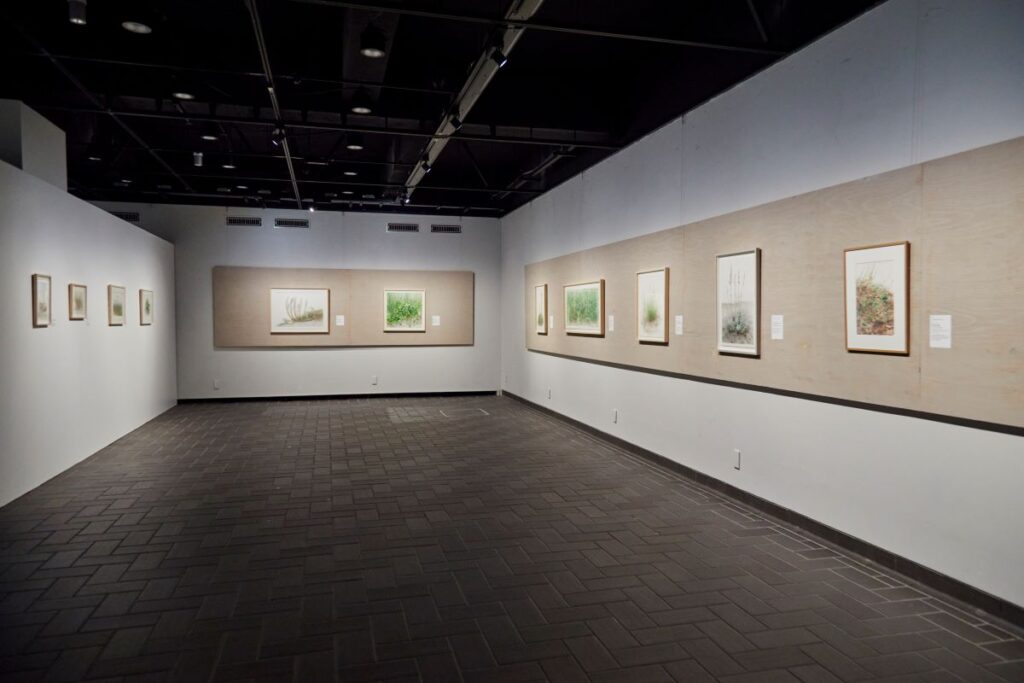
Mitsuko Kurashina, whose works are on display at Gallery B, was born in Aomori Prefecture and currently lives in Tokyo. She began drawing botanical illustrations in 2001.
Observing the changes in plant habitats caused by the tsunami following the Great East Japan Earthquake (2011), he has been making regular visits to the affected areas since 2013, painting the vegetation in watercolors. This exhibition features two botanical paintings of the Kanto region that he created when he was unable to visit the disaster-stricken areas, as well as 15 paintings he created during his research in Iwate, Fukushima, and Miyagi prefectures.
The numbers in the titles of the works are the latitude and longitude where the plants depicted were located. Kurashina says this is very important because she wanted to “suggest that the place actually exists, while at the same time depicting a scene that was only visible at that time.” By carefully observing and drawing each of the plants, which she has named “tsunami plants,” Kurashina explains, “I will explore what happened in that place and why the plants took root there; whether the seeds of the plants were carried there by the tsunami, sprouted due to the stirring up of the soil, or were carried there by heavy machinery during reconstruction work.”
Works in progress are also on display. For this exhibition, Kurashina has put a lot of effort into creating a white wisteria. The wisteria we know generally has vines that grow upwards, entangle the wisteria trellis, and drooping flowers. However, this wisteria has vines that creep along the ground, grow leaves, and bloom white flowers. In 2016, Kurashina had the opportunity to see a photo of white wisteria creeping along the ground, and she was determined to paint it, so she went to the site to investigate, and began painting last year. It is rare for white flowers to bloom on the ground. Kurashina believes that it must take a lot of energy to make them bloom. It is also a rare opportunity to be able to see the work in progress.
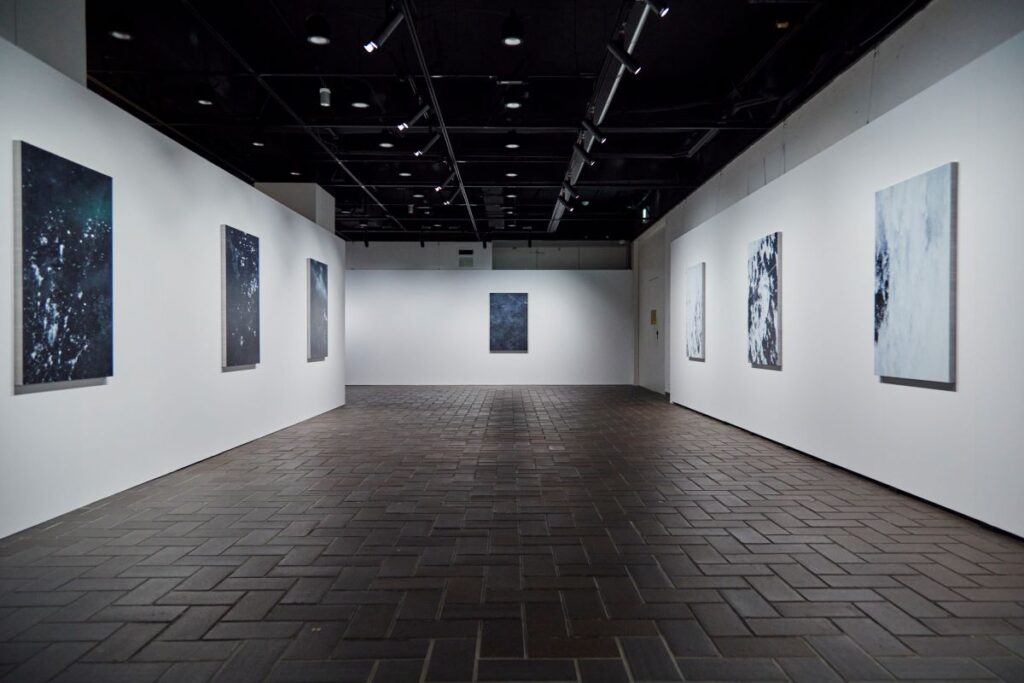
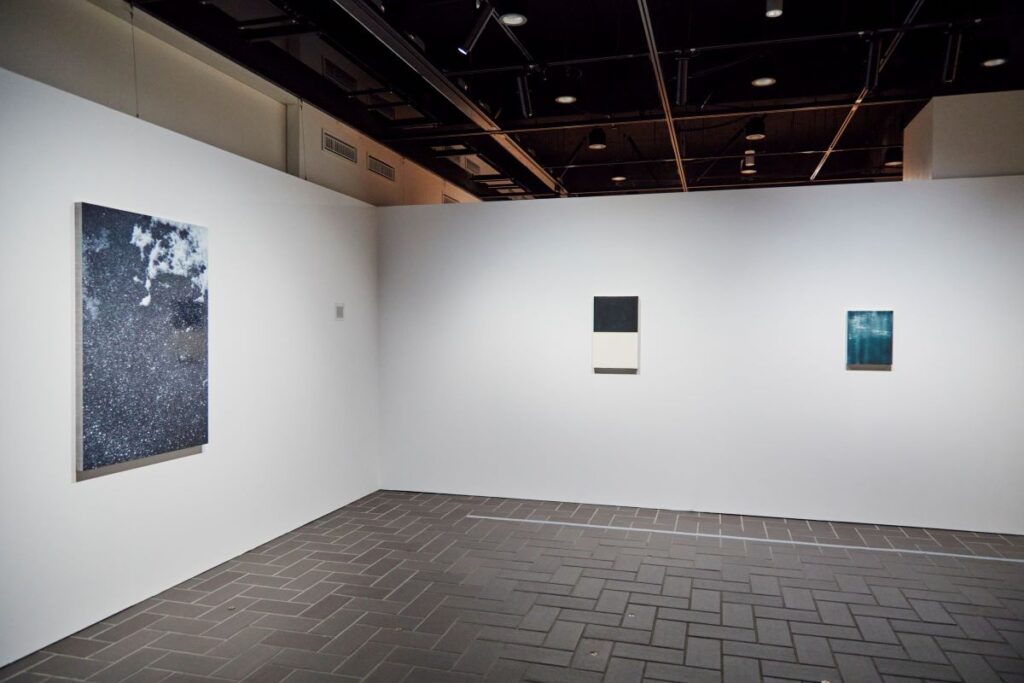
Yuichi Enomoto (born in 1974) was born and raised in Tokyo, and since 2018 has had an atelier in Nemuro, Hokkaido, and since this year he has also had an atelier in Itoigawa, Niigata, where he creates his works.
This exhibition features oil paintings based on the landscapes of Nemuro and a new work titled “Frost”, which uses aluminum panels to resemble ice.
When viewed from a distance, Swamp and Trees appears to be a black and white abstract painting, but when viewed up close, trees become visible in the black canvas.
Curator Ohashi conveyed Enomoto’s words, “I remember feeling surprised, happy, and also scared at the sudden scene that appeared in the deep forest where no one was around and no one ever came,” and introduced the work as one that captured the nature that Enomoto encountered — piled up white snow — with a fresh sensibility. Because it is a work simply carved in black and white, it has room for viewers to freely connect it to their own memories and expand their imaginations.
Meanwhile, the ten new pieces in the series “Frost”, which are painted on aluminium panels, capture the expressions created by snow caused by the strong winds coming from the sea.
“Even if you don’t have the experience of walking on ice, the many pieces lined up create a space that feels like you’re surrounded by ice,” says curator Ohashi. The 10 pieces lined up make you imagine the countless beautiful shapes woven by nature in Nemuro in winter. Incidentally, the last small piece on display shows animal footprints on the snow. At first glance, it is a quiet, monochrome world, but it expresses the presence of living things and the sparkle of life that Enomoto felt in Nemuro.
At the end of the exhibition, there is a work that represents spring. It is a vessel-shaped work with the motif of Corydalis ambiguus, a perennial plant found in Hokkaido that blooms from April to May. It is a new work created by Enomoto at the end of the exhibition.
Next to it is a slideshow of photos taken by Enomoto as reference material for his work, showing the change of seasons from spring in Nemuro. Not only does it fully convey the fresh sensations that Enomoto felt when he was fascinated by Nemuro, which offers a completely different landscape from Tokyo, but it is also interesting that it includes photos that are closely related to the works on display, such as a landscape on a frozen lake and Corydalis ambiguus flowers.
As you wander through the space, where a variety of works by five contemporary artists are on display, including photography, woodblock prints, oil paintings, watercolors, and installations, you will be inspired to awaken the sense of connection with nature that humans have innately, but which we often forget.
The exhibition catalogue is accompanied by a piece of mud-dyed cloth made on Amami Oshima.
It is made in the same workshop that produces the mud dyeing used by participating artist Machiko Miroko in her work.
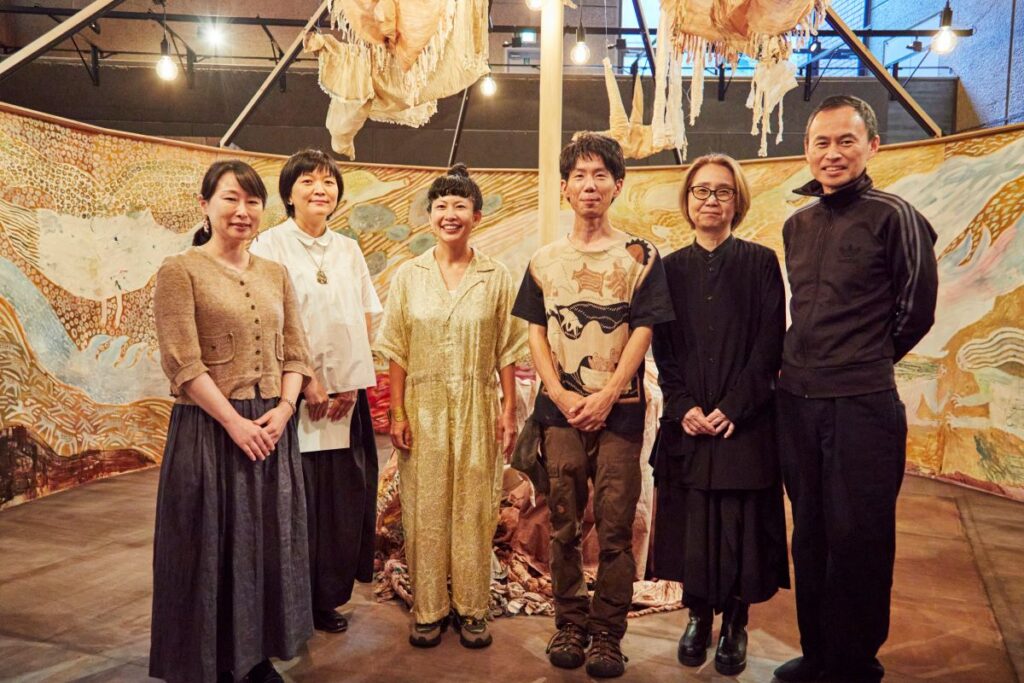
Photo by Wataru Suzuki
Exhibition details: Exhibition title: Listening to the Earth: Presence and Texture
The Whispering Land: Artists in Correspondence with Nature
●Period: July 20, 2024 (Saturday) to October 9, 2024 (Wednesday)
●Venue Tokyo Metropolitan Art Museum, Galleries A, B, and C
●Closed on Mondays, September 17th (Tues), September 24th (Tues) *Open on August 12th (Mon. holiday), September 16th (Mon. holiday), September 23rd (Mon. holiday)●Opening hours 9:30am-5:30pm, 9:30am-8pm on Fridays *Last entry 30 minutes before closing●Admission fee: 1,100 yen for adults, 700 yen for university and vocational school students, 800 yen for those 65 and over, free for high school students and younger*For details on discounts, such as the Summer Night Museum Discount, please visit the official exhibition website.
●Organizers: Tokyo Metropolitan Foundation for History and Culture, Tokyo Metropolitan Art Museum ●Special cooperation: Tsugawa Co., Ltd. ●Cooperation: Hokureki LLC, Mishimasha Co., Ltd., Gallery Camellia, Aomori Contemporary Art Center, Aomori Public University ●Contact: Tokyo Metropolitan Art Museum 03-3823-6921
For the latest information on events, please visit the official exhibition website.
https://www.tobikan.jp/daichinimimi
Article provided by: Kokosil Ueno
See other exhibition information


